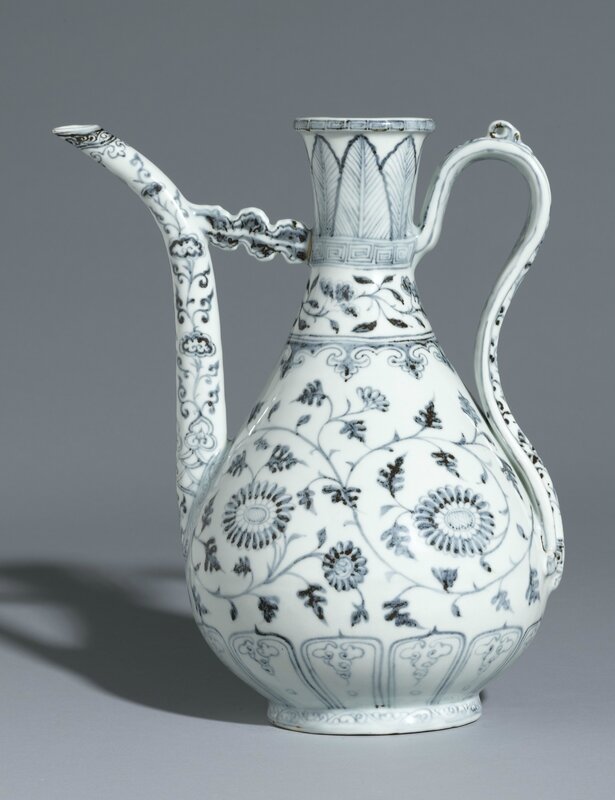An important blue and white ewer, Ming Dynasty, Hongwu Period


Lot 218. An important blue and white ewer, Ming Dynasty, Hongwu Period. 32.5 cm., 12 3/4 in. Estimation 15,000,000 — 20,000,000 HKD (1,508,955 - 2,011,939 EUR). Lot sold 18,040,000 HKD . Photo: Sotheby's.
the pear-shaped body tapering up to a narrow neck and a square-lipped rim, set with a tall curved spout connected to the neck by a cloud-shaped strut, opposite an arched strap handle accented by a central raised ridge and a pointed terminal, the handle surmounted by a small lug, freely painted around the body with a broad chrysanthemum scroll issuing two large blossoms on each side with attendant smaller flowers and buds further wreathed by serrated leaves, between a border of petal lappets enclosing 'cloud' motifs above a 'classic' scroll encircling the foot and pendent trefoils collaring the shoulder, the neck drapped in a scroll of flowering pomegranate and upright plantains divided by a key-fret border repeated on the square-lipped rim, the loop handle decorated with a vertical lotus scroll on the exterior and another on the underside, further outlined with double-lines along the edges, the V-shaped terminal picked out with key-fret surrounded by 'cash' motifs on the bosses, the spout painted with overlapping ruyi sprouting upright floral sprigs below a 'classic' scroll border suspending trefoils on the tip-end, the underglaze blue of characteristic greyish tone well accented with areas of 'heaping and piling', the base glazed.
Provenance: Sotheby's Hong Kong, 30th April 1991, lot 10.
Collection of T.T. Tsui.
Christie's Hong Kong, 27th October 2003, lot 627.
Christie's Hong Kong, 28th November 2005, lot 1408.
Litterature: Sotheby's Hong Kong – Twenty Years, 1973-1993, Hong Kong, 1993, no. 38.
Sotheby's. Thirty Years in Hong Kong, Hong Kong, 2003, p. 200, no. 203.
The present piece is a fine and elegant example of Hongwu period blue-and-white ewers of this refined pear form. It represents the bridge between the robust and dynamic style of the preceding Yuan period and the more regulated and refined style celebrated in early Ming dynasty porcelains. The establishment of an imperial factory in Jingdezhen in the second year of the Hongwu reign (1369) saw the court take control of the distribution as well as the range, style and quality of their wares.
Fragments of a Hongwu ewer of this type, but decorated with a lotus scroll, was discovered in 1994 at Dongmentou, Zhushan, and included in the exhibition Imperial Hongwu and Yongle Porcelain Excavated at Jingdezhen, Chang Foundation, Taipei, 1996, cat. no. 4. See two related ewers, one painted with four flower sprays, from the Qing Court collection and still in Beijing, illustrated in The Complete Collection of Treasures of the Palace Museum. Blue and White Porcelain with Underglazed Red (I), Hong Kong, 2008, pl. 15; and the other depicting a peony scroll, formerly from the collection of Kushi Takushin and now in the Idemitsu Museum of Arts, Tokyo, published in Sekai toji zenshu, vol. 14, 1976, pl. 1.
Compare copper-red decorated ewers of this type and various floral decoration, such as one from the Qing Court collection, illustrated in The Complete Collection of Treasures of the Palace Museum, op. cit., pl. 201; one from the collection of Sir Percival David and now in the British Museum, London, included in Sekai toji zenshu, op. cit., p. 156, fig. 13; and a third example painted with banana trees, from the collection of R.H.R. Palmer, sold in our London rooms, 27th November 1962, lot 16, and published inChinese Ceramics in the Idemitsu Collection, Tokyo, 1987, col. pl. 150.
Blue-and-white wares of the Hongwu period are rarer than their copper-red counterparts which has been attributed to the scarcity of imported cobalt as a result of strictly regulated foreign trade. A large number of Hongwu period porcelains were discovered at Jingdezhen in the 1990s including cobalt-decorated pieces. According to Regina Krahl in Chinese Ceramics from the Meiyintang Collection, vol. 4, pt. 1, London, 2012, p. 52, this indicates that many experiments were made, probably with local cobalt, but with very unsatisfactory results.
Sotheby's. Important Ming Porcelain from a Private Collection. Hong Kong | 08 oct. 2013.

/https%3A%2F%2Fprofilepics.canalblog.com%2Fprofilepics%2F1%2F0%2F100183.jpg)
/https%3A%2F%2Fstorage.canalblog.com%2F03%2F02%2F119589%2F96711876_o.jpg)
/https%3A%2F%2Fstorage.canalblog.com%2F11%2F31%2F119589%2F94773502_o.jpg)
/https%3A%2F%2Fstorage.canalblog.com%2F20%2F83%2F119589%2F94772815_o.jpg)
/https%3A%2F%2Fstorage.canalblog.com%2F26%2F72%2F119589%2F75604929_o.jpg)
/https%3A%2F%2Fstorage.canalblog.com%2F59%2F60%2F119589%2F26458628_o.jpg)



/image%2F1371349%2F20240416%2Fob_2a8420_437713933-1652609748842371-16764302136.jpg)
/image%2F1371349%2F20240414%2Fob_83ee65_2024-nyr-22642-0954-000-a-blue-and-whi.jpg)
/image%2F1371349%2F20240414%2Fob_15808c_2024-nyr-22642-0953-000-a-blue-and-whi.jpg)
/image%2F1371349%2F20240414%2Fob_e54295_2024-nyr-22642-0952-000-a-rare-blue-an.jpg)